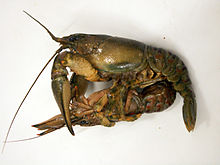Camber cancer
| Camber cancer | ||||||||||||
|---|---|---|---|---|---|---|---|---|---|---|---|---|

Crayfish ( Orconectes limosus ) |
||||||||||||
| Systematics | ||||||||||||
|
||||||||||||
| Scientific name | ||||||||||||
| Orconectes limosus | ||||||||||||
| ( Rafinesque , 1817) |
The American crayfish ( Orconectes limosis , Syn. : Cambarus affinis ) is a from North America originating crayfish , which occurs as invasive alien species in Europe. It is already widespread in Western and Central Europe and is now the most common crayfish species there. The crayfish is still spreading, with the current fronts of spread mainly in various water systems in Eastern and Southeastern Europe. It is also found in Corsica . In Germany, the expansion in southern areas (Lake Constance and Danube system) has not yet been fully completed. In many cases, the spread is favored by active relocation of the animals by humans, but this is prohibited according to the fishing rights of the federal states and the Federal Nature Conservation Act. The Kamberkrebs is the carrier of the cancer plague , against which it is immune. Wherever crayfish occur, they lead to the disappearance of native crayfish.
The common name American crayfish is imprecise or misleading, because there are several originally American crayfish species in Central Europe.
description
The crayfish does not grow larger than 12 cm. The side edges of the rostrum, also known as the “tip of the nose”, run more or less parallel and the eye ridge is one pair. The strong lateral spines in the cheek area in front of the neck furrow, hence the English name spiny-cheek crayfish, are typical of the species and decisive for the determination . The orange tips of the scissors, which are set off in color with a dark band, and the rust-red cross bars on the back of the pleon (abdomen) are also characteristic. The rest of the body color varies between gray, olive and slightly brownish. The top of the scissors is often furry.
Importation and expansion in Europe
The original distribution area of the crayfish is in the east of the USA. There, the species is paradoxically endangered in some water systems. The crayfish was introduced to Europe in 1890 by the fisherman Max von dem Borne . Around 90 animals of unknown origin were introduced into the Oder river system on a trial basis . The species found ideal conditions there and subsequently quickly spread to the north and west of Germany. In many cases, the spread was supported by active stocking in the hope of being able to use the crayfish as a substitute for the crayfish in fishing. The current tendency of the crayfish to spread is mainly due to the active spread of established populations. However, illegal abductions over long distances still occur regularly. Isolated or artificial standing waters along the large rivers where camber crabs occur are particularly affected by such illegal trafficking.
In 2016 the crayfish was added to the “List of undesirable species” for the European Union .
biology
The crayfish is mostly nocturnal, but also regularly leaves its hiding spots during the day. He creates caves in a suitable substrate, but can also hide in the muddy ground or between aquatic plants. The crayfish mainly colonizes lakes and larger rivers with low flow speeds. The demands on the water are low - the cancer has survived in the rivers of northern Germany, which used to be heavily polluted by industrial sewage. Rapidly flowing, small rivers and higher altitudes are usually avoided by the crayfish, which is why the upper reaches of rivers are often refuges for native crayfish, which are safe from active spread of crayfish.
Compared to the European crayfish, the crayfish has a fast life cycle and a high number of offspring, it is - unlike the European crayfish - an r-strategist . The mating season extends from late summer to early spring. During this time the males are in the so-called "Form I" and try to overwhelm the females with persistent attacks in order to mate with them. The males are not very picky, and attempts to mate with inferior males and other crayfish species have also been observed. After the mating season, the females lay eggs in spring, which, depending on the water temperature, can develop within a few weeks. The first juvenile stages hatch in late spring or early summer and then remain on the mother for at least two moults. Then the young animals move on to an independent way of life. Under favorable conditions, the young can reach sexual maturity at the end of the second summer, i.e. at around 1.5 years of age. The species can quickly build up high densities of individuals.
Individual evidence
- ↑ C. Chucholl, P. Dehus: Crayfish in Baden-Württemberg . Fisheries Research Center Baden-Württemberg (FFS), Langenargen 2011.
- ↑ List of Invasive Alien Species of Union Concern. (PDF) Retrieved July 15, 2016 (PDF; 333 kB).
Web links
- Carsten Burk: Danger for the noble crayfish - endangerment of the native noble crayfish from alien crayfish species . 1998.
- Species description at Wirbellose.de
- Orconectes limosus inthe IUCN 2013 Red List of Threatened Species . Posted by: S. Adams, GA Schuster, CA Taylor, 2010. Retrieved January 19, 2014.
